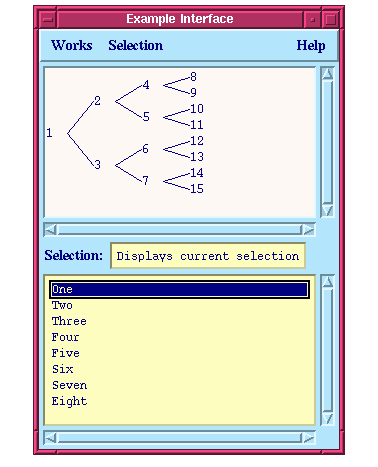




Common LispWorks User Guide, Liquid Common Lisp Version 5.0
15 Example: Using The Interface Builder
This example shows you how to use the interface builder to design a simple interface. It explains how to create the layout and the menu system, and demonstrates some of the attributes that you can set. Finally, the interface is saved to a file, and combined with some other simple code to produce a working example. You are strongly advised to read Chapter 14, "The Interface Builder", before (or in conjunction with) this chapter. It is also useful, though not essential, if you are familiar with the editor (Chapter 8), the listener (Chapter 7), and Common Lisp systems. The final interface created is shown in Figure 15.1. It consists of a column layout which contains a graph pane, a display pane, and a list panel.

Figure 15.1 Example interface
Any select action performed in either the graph pane or the list panel is described in the display pane. This includes the following actions:
- Selecting any item
- Deselecting any item
- Extending the selection (by selecting more than one item)
Double-clicking any item in either the graph pane or the list panel displays a dialog which shows which item you double-clicked. Lastly, there are menu commands available which display, in a dialog, the current selection in either pane. Choose Selection > Graph to see the currently selected items in the graph pane, and choose Selection > List Panel to see the currently selected items in the list panel.
- 15.1 - Creating the basic layout
-
- 15.2 - Specifying attribute values
-
- 15.3 - Creating the menu system
-
- 15.4 - Specifying callbacks in the interface definition
-
- 15.5 - Saving the interface
-
- 15.6 - Defining the callbacks
-
- 15.7 - Creating a system
-
- 15.8 - Testing the example interface
-
Common LispWorks User Guide, Liquid Common Lisp Version 5.0 - 18 OCT 1996 




Generated with Harlequin WebMaker











